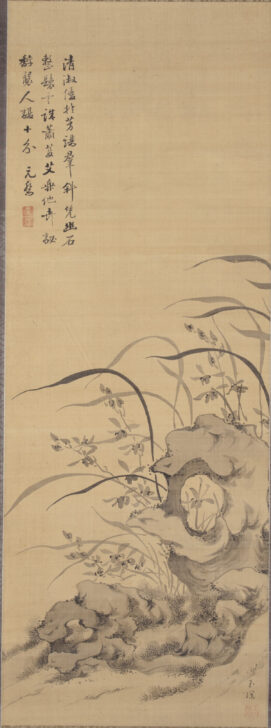Orchids and Rock with Calligraphy
Ikeno Gyokuran

Description
Gallery Rotation Spring/Summer 2012
Tokuyama Gyokuran
Japan, 1728–1784
Orchids and Rock with Calligraphy
Edo period (1615–1868)
1750–84
Hanging scroll, ink on silk
Gift of Ellen and Richard Laing, 2006/2.9
Tokuyama Machi (1727/28–1784) or Gyokuran (her artist name) was born to an educated mother, a teahouse owner who was known for her skilled poetry. When she was young, Gyokuran studied painting under the artist Yanagisawa Kien (1706–1758), who also taught her future husband, Ike Taiga (1723–1776). After marrying, Gyokuran continued her studies under her husband, who became the most well-known painter of the Nanga school, a group of Sinophile Japanese painters who patterned themselves after the self-taught scholar-artist (literati) painters of China.
Gyokuran was an accomplished poet and painter in the Japanese literati school, inspired in her subjects and painting style by the Chinese masters. This work alludes to the beloved theme of the “Four Gentlemen,” which consisted of bamboo, orchids, plums, and chrysanthemums or pines. These plants are lauded as the physical embodiment of an ideal scholarly gentleman, who should be strong like bamboo, gentle like the orchid, brave like the early-blooming plum, steadfast like the chrysanthemum, and long-lived, like the pine.
Subject Matter:
Gyokuran (her artist name) or Tokuyama Machi (1727/28-1784) was born to educated mother, who was the owner of a teahouse and was known for her skilled poetry composition. While she was young, Gyokuran studied painting under the artist Yanagisawa Kien (1706-1758). Kien also taught Gyokuran’s future husband, Ike Taiga (1723-1776), the most well-known Japanese literati painter. After the marriage, Gyokuran continued her studies under the guidance of her husband, who rose to prominence for his unparalleled brushwork among the contemporary community of painters and scholars. Gyokuran was a skilled poet and painter in the Nanga or Southern Painting school, a group of Synophile Japanese painters who took subject matters and painting styles from Chinese literati masters.
This work alludes to the beloved theme of the “Four Gentlemen,” which consisted of bamboo, orchids, plumbs and chrysanthemums or pines. A gentleman should be strong like bamboo, gentle like the orchid, brave like the early blooming plumb, steadfast like the chrysanthemum and long-lived, like the pine. These plants are lauded as the physical embodiment of an ideal scholarly gentleman.
Physical Description:
Hanging scroll with calligraphy and landscape imagery. Three lines of calligraphy adorn the upper left side while opposite is imagery of orchids, grass and a rock.
Usage Rights:
If you are interested in using an image for a publication, please visit https://umma.umich.edu/request-image/ for more information and to fill out the online Image Rights and Reproductions Request Form.